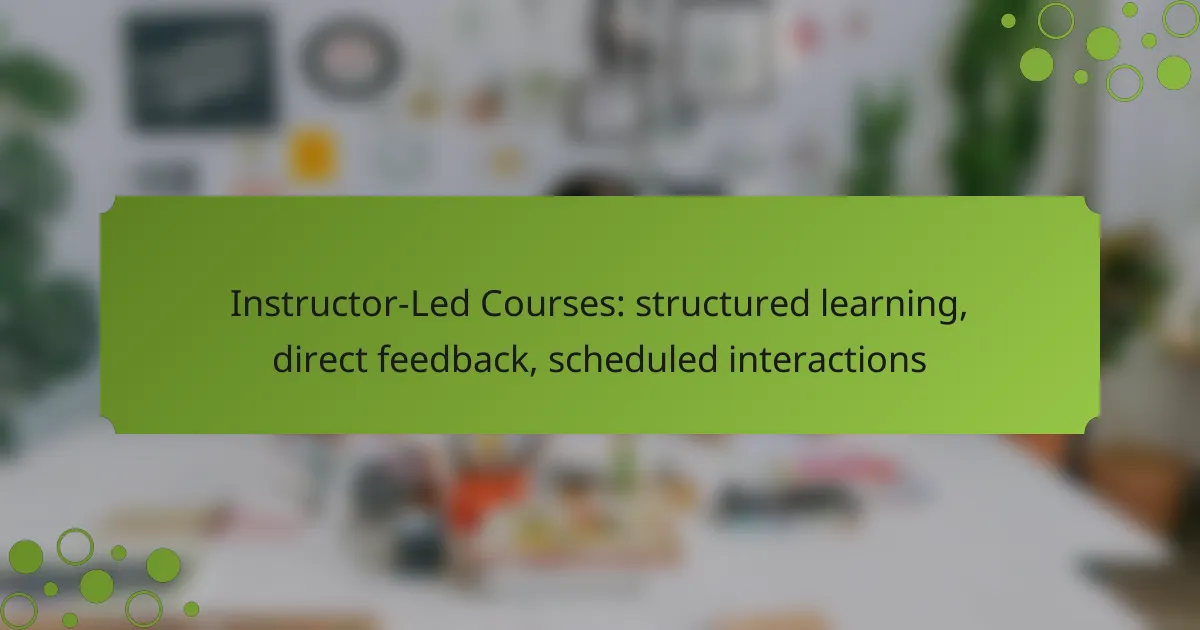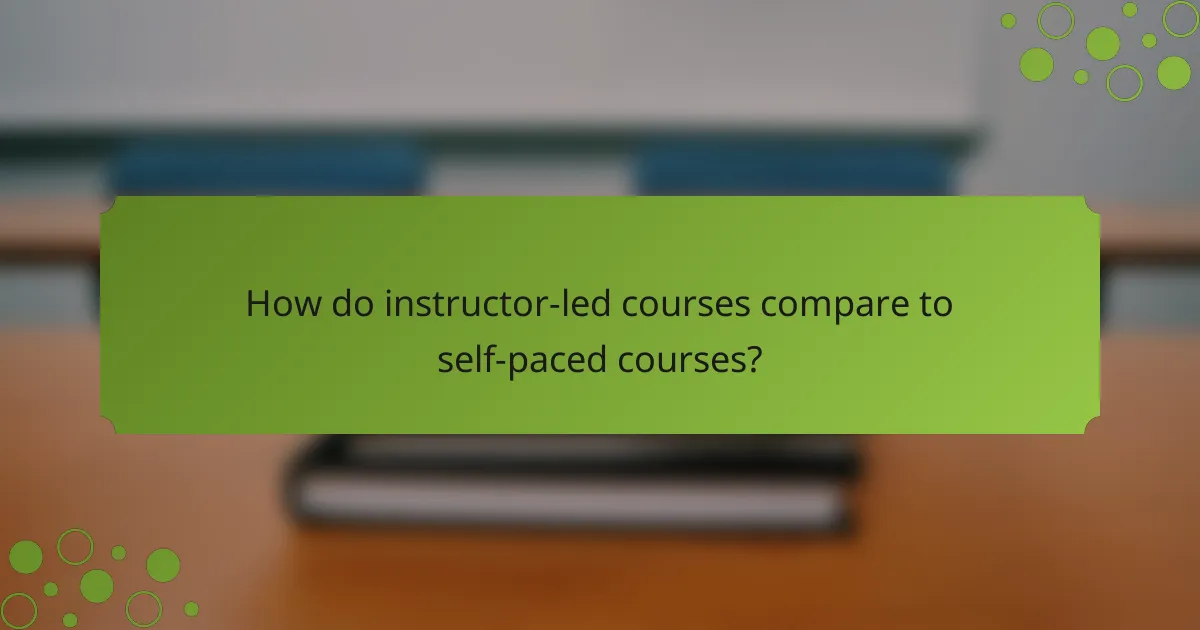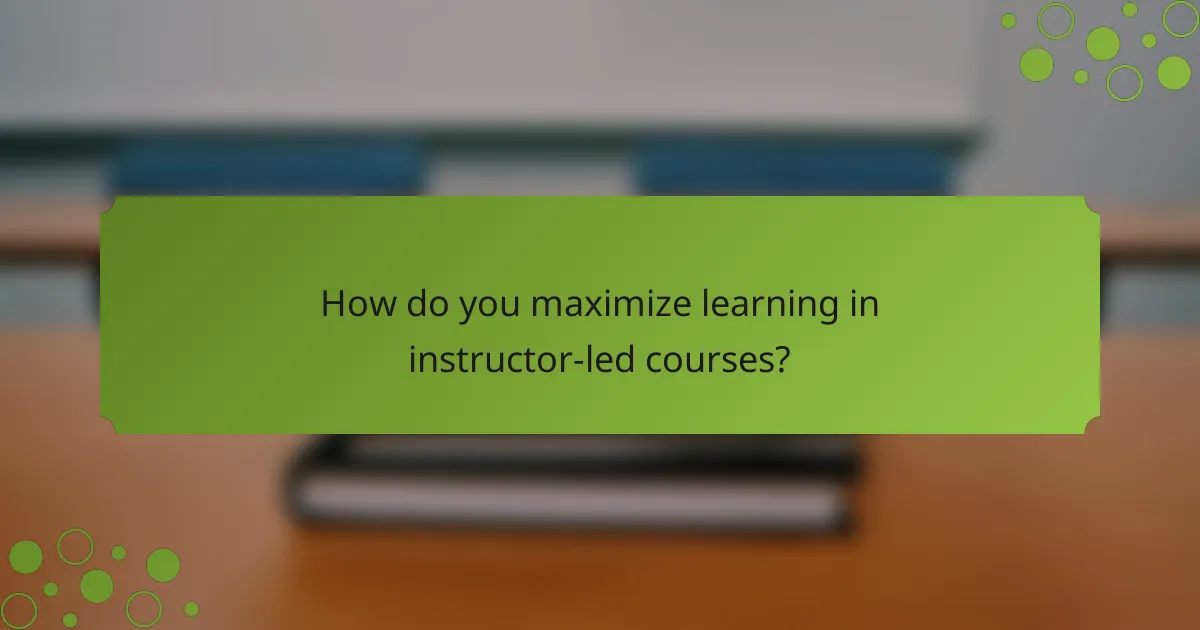
Instructor-led courses provide a structured learning environment that emphasizes direct feedback and scheduled interactions, making them an effective choice for skill acquisition. By fostering engagement between instructors and students, these courses enhance the educational experience and cater to various subjects and skill levels.

What are the benefits of instructor-led courses?
Instructor-led courses offer structured learning, direct feedback, and scheduled interactions, making them an effective way to acquire new skills. These courses create an environment conducive to learning, where students can engage with instructors and peers, enhancing the overall educational experience.
Structured learning environment
A structured learning environment provides a clear framework for students, outlining objectives, timelines, and resources. This organization helps learners stay focused and motivated, as they can easily track their progress and understand what is expected of them.
Instructors typically design courses with a logical progression, ensuring that each topic builds on the previous one. This method is particularly beneficial for complex subjects, where understanding foundational concepts is crucial for mastering advanced material.
Direct feedback from instructors
Direct feedback from instructors is a key advantage of instructor-led courses. Learners receive immediate responses to their questions and concerns, allowing for quick adjustments and deeper understanding of the material.
This real-time interaction fosters a supportive learning atmosphere, where students can clarify doubts and refine their skills. Instructors can provide personalized guidance, helping learners to overcome specific challenges and enhance their performance.
Scheduled interactions with peers
Scheduled interactions with peers facilitate collaboration and networking, which are essential components of the learning process. Group discussions and team projects encourage students to share ideas and perspectives, enriching the overall educational experience.
These interactions can lead to lasting professional relationships and a sense of community among learners. Engaging with peers also helps to reinforce knowledge, as teaching and explaining concepts to others can deepen one’s understanding.
Enhanced accountability for learners
Instructor-led courses enhance accountability for learners by establishing deadlines and expectations. Knowing that they must complete assignments and participate in discussions encourages students to stay on track and manage their time effectively.
This accountability can be particularly beneficial for individuals who may struggle with self-discipline in self-paced learning environments. Regular check-ins and assessments help ensure that learners remain engaged and committed to their educational goals.
Access to expert knowledge
Access to expert knowledge is a significant benefit of instructor-led courses. Instructors often have extensive experience and specialized knowledge in their fields, providing learners with insights that are not easily found in textbooks or online resources.
Students can ask questions and engage in discussions that deepen their understanding of complex topics. This access to expertise can also inspire learners to pursue further studies or careers in their chosen fields, as they gain a clearer picture of industry standards and practices.

How do instructor-led courses compare to self-paced courses?
Instructor-led courses provide structured learning with scheduled interactions, while self-paced courses offer flexibility in timing and pace. The choice between the two depends on individual learning preferences and goals.
Real-time engagement vs. flexibility
Instructor-led courses emphasize real-time engagement, allowing learners to interact directly with instructors and peers. This immediate interaction can enhance understanding and retention of material.
In contrast, self-paced courses offer flexibility, enabling learners to study at their own convenience. This can be beneficial for those with busy schedules or varying learning speeds, but it may lack the motivation that comes from scheduled classes.
Immediate feedback vs. delayed responses
One of the key advantages of instructor-led courses is the immediate feedback provided by instructors. This instant response can help clarify doubts and reinforce learning quickly.
Self-paced courses often result in delayed feedback, as learners may have to wait for instructor responses or rely on automated systems. This can slow down the learning process and lead to misunderstandings if questions go unaddressed for too long.
Community support vs. solitary learning
Instructor-led courses foster a sense of community among participants, encouraging collaboration and support. This shared learning environment can enhance motivation and accountability.
On the other hand, self-paced courses may lead to solitary learning experiences, where individuals miss out on the benefits of peer interaction. While online forums can provide some community support, they may not replicate the dynamic of a live classroom setting.

What platforms offer instructor-led courses?
Several online platforms provide instructor-led courses, which combine structured learning with real-time feedback and scheduled interactions. These platforms cater to various subjects and skill levels, making it easier for learners to find suitable courses.
Coursera
Coursera partners with top universities and organizations to offer a wide range of instructor-led courses. These courses often include live sessions, allowing students to interact directly with instructors and peers. Many courses are available for free, with the option to pay for a certificate upon completion.
When selecting a course on Coursera, consider the course duration, the level of interaction, and the credentials of the instructors. Look for courses that offer hands-on projects or peer-reviewed assignments to enhance your learning experience.
edX
edX offers high-quality courses from prestigious institutions, featuring both self-paced and instructor-led options. Many instructor-led courses include live discussions and Q&A sessions, providing opportunities for direct feedback. Some courses are free, while others require a fee for certification.
To maximize your learning on edX, check the course syllabus for scheduled interaction times and ensure they fit your availability. Engaging with fellow students during these sessions can deepen your understanding of the material.
Udacity
Udacity specializes in tech-focused courses, particularly in areas like programming, data science, and artificial intelligence. Their instructor-led programs often include mentorship and project reviews, providing personalized guidance. While Udacity courses typically require a fee, they are designed to be intensive and career-oriented.
When enrolling in a Udacity course, consider the time commitment and the specific skills you wish to acquire. The hands-on projects are crucial for building a portfolio, so choose courses that align with your career goals.
LinkedIn Learning
LinkedIn Learning offers a vast library of courses across various fields, with many featuring instructor-led elements. While most content is pre-recorded, some courses include live sessions or Q&A opportunities. Subscriptions provide access to the entire course catalog, making it a flexible option for learners.
To get the most out of LinkedIn Learning, explore courses that align with your professional development goals. Take advantage of the platform’s personalized recommendations based on your interests and career path.

What factors should you consider when choosing an instructor-led course?
When selecting an instructor-led course, consider the course content, instructor qualifications, class size, and scheduling. These factors significantly influence the learning experience and effectiveness of the course.
Course content relevance
Ensure the course content aligns with your learning objectives and professional goals. Look for courses that cover current trends and practical applications in your field.
Review the syllabus or curriculum outline to assess whether it includes essential topics and skills. This will help you determine if the course will meet your needs and expectations.
Instructor qualifications
The instructor’s expertise and experience are crucial for a successful learning experience. Research their background, including education, industry experience, and teaching credentials.
Instructors with relevant real-world experience can provide valuable insights and practical examples, enhancing the learning process. Look for reviews or testimonials from previous students to gauge their effectiveness.
Class size and interaction level
Class size can significantly impact the level of interaction and personalized feedback you receive. Smaller classes typically allow for more engagement and direct communication with the instructor.
Consider your preferred learning style; if you thrive in collaborative environments, opt for courses that promote discussion and group activities. A class size of 10-20 students often strikes a good balance for interaction.
Scheduling and time commitment
Evaluate the course schedule and the time commitment required. Make sure it fits your availability and does not conflict with other responsibilities.
Some courses may offer flexible or hybrid formats, allowing you to balance learning with work or personal commitments. Be aware of any prerequisites or assignments that may require additional time outside of scheduled classes.

How do you maximize learning in instructor-led courses?
To maximize learning in instructor-led courses, engage actively with the material, seek feedback, and participate in scheduled interactions. This approach enhances understanding and retention through structured learning and direct communication with instructors.
Engagement with the material
Active engagement with course content is crucial for effective learning. This can involve taking notes, asking questions, and participating in discussions. For instance, students should aim to contribute at least once per session to reinforce their understanding and clarify any doubts.
Utilizing supplementary resources, such as textbooks or online articles, can further deepen comprehension. Setting aside regular study times to review material can also help solidify knowledge gained during the course.
Seeking feedback
Direct feedback from instructors is essential for identifying strengths and areas for improvement. Students should proactively ask for feedback on assignments and participation to understand their progress better. Regular check-ins with instructors can provide personalized insights that enhance learning outcomes.
In addition, peer feedback can be valuable. Engaging with classmates for constructive critiques can foster a collaborative learning environment and expose students to diverse perspectives.
Participating in scheduled interactions
Scheduled interactions, such as live sessions or group activities, create opportunities for real-time learning and networking. Attending all scheduled classes and actively participating can significantly impact overall performance. Students should prioritize these interactions to benefit from the instructor’s expertise and peer discussions.
To maximize these interactions, come prepared with questions or topics for discussion. This preparation not only shows initiative but also encourages a more dynamic and engaging learning experience.


